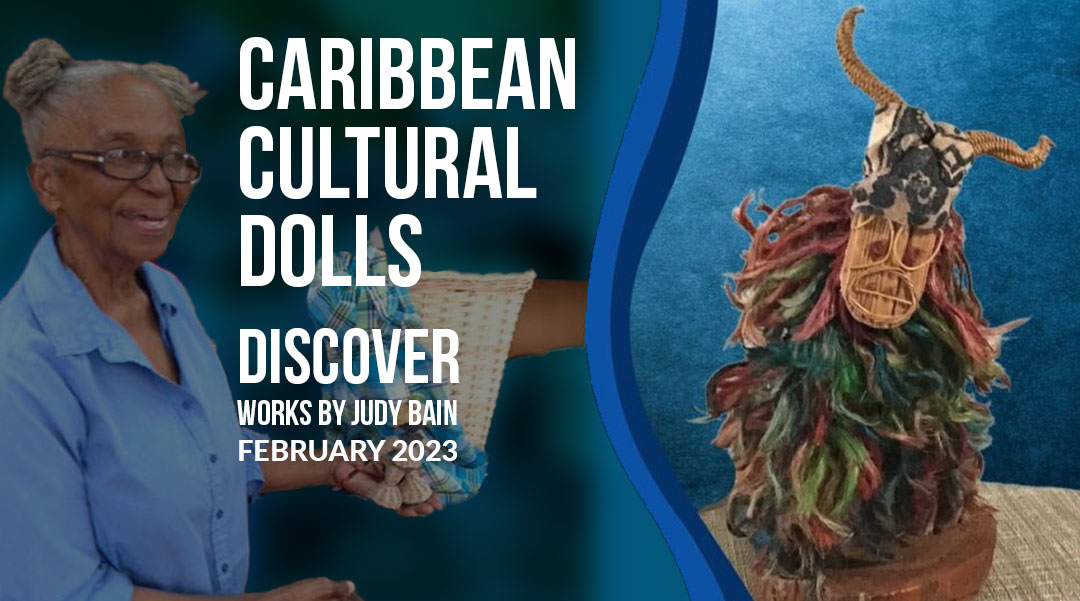
CARIBBEAN CULTURAL DOLLS
Judy Boldon-Bain may be a pensioner but she has not retired.
On display until Feb 28th only! Celebrating Caribbean islanders’ ancestry and their connections to West African culture, Bain’s ratan dolls merge cultures to bring us universal characters like Dame Lorraine, symbolizing fertility, Fancy Sailor, teller of tall tales, and Queen Mary rebel leader. Included with museum admission.
The 79-year-old occupational therapist has been in the business of therapeutic healing since 1965. Now she is also in the business of promoting this country’s culture through hand-woven wicker dolls, under the brand Caribbean Cultural Dolls (CCD).
“I worked with persons with either physical or mental/emotional disabilities and what doing the doll does, is it pushes them to focus on relaxing so they can open up and speak out. It encourages them to utilise their mobility to do the craft and focus on the end product,” she explained.
And while she did follow the traditional methods learnt through her studies both locally and abroad, Boldon-Bain decided years ago, when she crafted her first doll, to incorporate the activity into her exercises.
Caribbean Culture Dolls Pierrot Grenadec
She said she started weaving dolls as a challenge to herself when she went to live in St Croix, US Virgin Islands, in 1985. She soon realised she could use weaving as a therapeutic tool and began sourcing rattan, a vining palm, mostly found in the tropical rainforests of South East Asia.
While in St Croix, her dolls became a hit. She said the moko jumbies were almost “like a national character” and tourists often likened the Dame Lorraine to the children’s book character Mary Poppins, because they sported an umbrella.
“The first dolls represented the bele dancer, the quadrille dancer, the market woman. Each came with a story card that explained the design. The moko jumbie was woven and became very popular with buyers, both local and visitors.
“At this point I realised that I needed to establish a production base and returned to Trinidad to teach in three villages. I spent roughly three weeks and taught one design in each village – Moruga, Cumana and Grande Riviere,” she recalled.
Caribbean Culture Dolls Blue Transition
The project entailed, dyeing the material, bundling and sending it down to the villagers, via a co-ordinator, who then returned to the villages, paid for the woven dolls and posted them back to her in St Croix. This continued for over five years, with Boldon-Baine doing all of the marketing.
Recognising that her “tool” had turned into a business, she copyrighted the dolls under a registered company, Mayocheton Enterprises. Not only are her dolls durable but the buyer is informed about its history through the story cards.
Now she is assisted by her two nieces Jeanelle George, who handles CCD’s marketing and Simone Edwards-Ray, who does the graphics on the cards and posters. Her husband, Cedric, she joked, is her biggest supporter and critic.
While Boldon-Baine said business has been doing well from inception, for her, it’s not solely about the income. It’s her way of promoting our culture, while connecting people with each other.
“I see this as a way of helping to keep this vital part of the Trinidad carnival alive. I am trying hard to establish a foundation which will continue after I am gone. I have been teaching since returning to Trinidad, but need more weavers. Although I believe that the possibility is there to make a very successful and lucrative company, it is very much a niche product, appealing to Trinis at home and abroad, Caribbean people with similar cultural figures, people of the Caribbean and African Diaspora in North America and Europe – and therefore we need to market accordingly. That is a challenge.”
Working on Caribbean Culture Dolls
However, having worked in a highly demanding field filled with challenges, Boldon-Baine, mother of three and grandmother of eight, refuses to be daunted. Neither is she ever afraid to speak her mind.
“Sometime in my youth I developed a pet peeve: seeing people hang items that are not of our culture, climate or country – like snowmen, sledges, candy canes – on Christmas trees. I decided to make miniature dolls to nicely replace the foreign ones.”
Over the years, Boldon-Baine increased the number of her designs from four to 12, focusing on traditional carnival characters. At present she has three steady weavers working alongside her, but took the opportunity to appeal for others to see the value of the activity. She offers interested weavers the chance to earn without the need for start-up capital, by firstly teaching them the artform, then providing all the necessary materials.
She then buys the doll back from the weaver at a fraction of the selling price. However, knowing that people learn at different levels, if dolls do not meet the CCD standard, then Boldon-Baine offers either a lower percentage payment or the chance to “rip it all out and start over.” A stickler for consistency, Boldon-Baine said because her brand is already known for a certain standard, she feels compelled to insist it’s maintained.
She can be found at the popular Up Market during its seasonal peak periods from September through December. Some of her dolls can also be found in souvenir shops at Piarco Airport. The dolls, which were once internationally recognised in a black doll magazine, by a doll collector, are also steadily being marketed and sold in at least three stores in St Croix. Several years ago, through the Ministry of Community Development, her dolls were featured at Carifesta and earned a favourable response, she recalled.
When she had returned to TT many years ago and had taken a job at the St Ann’s Hospital, she used to teach her patients the craft. The material was sourced through the Blind Welfare Association, which also used rattan to weave their baskets.
Boldon-Baine has now partnered with the association once again and will be both sourcing material through it and selling her dolls alongside its woven baskets.
As for its reach, Boldon-Baine said confidently: “If I can sell one doll to each person in TT, then add that to the Trinis living abroad, who share a love of culture, all I need to do is reach them and I can market CCD to them.
“It doesn’t stop there though. Not at all. This region shares similar characters. They may have different ways of expression and history, but often quite a few similarities, often in appearance.”















